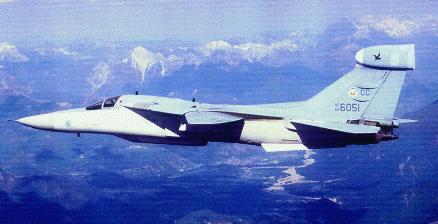EF-111A Raven

Mission
The EF-111A Raven is designed to provide electronic countermeasures support. The EF-111A can detect, sort, identify and nullify different enemy radars.
Features
The EF-111A is a modified F-111A. The F-111A was well-suited for modification to the role of an airborne electronic warfare platform because of its structural strength, maneuverability and performance -- including the ability to penetrate enemy airspace and escape at supersonic speed.
Exterior modifications include a narrow canoe-shaped radome, about 16 feet (4.85 meters) long, mounted under the fuselage, which house antennas for the high-powered jamming transmitters. Also, a fin-tip pod is mounted on the reinforced vertical stabilizer to house receiving antennas and ancillary equipment, including a processor to detect hostile radar emissions. The total equipment weight is about 3.5 tons (3,150 kilograms).
Interior modifications include a rearranged cockpit -- the right-seat crew member is an electronic warfare officer responsible for navigation, terrain-following flight and electronic warfare operations. The electronic warfare officer plans jamming tactics in advance, and then programs, operates and monitors the jamming system. Previous radar-jamming aircraft required several operators and more equipment to perform radar-jamming sessions.
The primary electronic countermeasures unit is the AN/ALQ-99E jamming subsystem. It is an improved version of the U.S. Navy's first ALQ-99 jamming subsystem. Improvements to the Navy version include: capability to more rapidly detect and identify enemy transmissions; greater automation (and less reliance on human involvement and manual operations); expanded computer functions providing sophisticated and flexible jamming options; and more independent jamming signals over a wider range of frequencies.
The AN/ALQ-99E detects radar signals, processes them and compares them to known threat radar characteristics stored in an on-board computer. Jamming subsystem receivers scan across frequency bands under computer or manual control. When threats are identified, appropriate countermeasures are initiated. Information about new threats, not in the memory of the computer, can be fed into the system either through entries on the electronic warfare officer's cockpit keyboard or by programming the computer via a cassette that plugs directly into the plane. Changing the programming takes about five minutes if plug-in modules are used. The electronic warfare officer can test the information and, if necessary, make corrections using the keyboard and cockpit display unit.
A self-protection subsystem is designed to protect the EF-111A against radar-directed, anti-aircraft artillery, and missile or aircraft threats.
The EF-111A provides protection by using a jamming orbit where it stands off from threat radars to cover friendly aircraft entering and leaving the threat areas, or by using the aircraft's high-performance capabilities to directly support attacking forces. In the direct support mission, the Raven may fly as in escort position or enter a threat area to the best jammer position. Ravens engaged in direct support often use the extensive night terrain-following capability built into the basic F-111 design.
The aircraft are being updated with modern digital navigation and flight-control systems, which equip the airplane with ring-laser gyro and global-positioning navigation systems, as well as improved controls and displays. The radar and terrain-following flight system are also being updated.
Background
During Operation Desert Storm all available Ravens were deployed to Middle East bases to support U.S. and allied combat operations. More than 1,300 sorties were flown, with many missions penetrating deep into enemy territory. All major allied air attacks were supported by Ravens that teamed with other Air Force and allied electronic combat units to cause a rapid collapse of the enemy air defense system. One EF-111A was lost during combat.
The program to convert several F-111A's to EF-111A electronic warfare prototypes and to evaluate their ability to provide electronic countermeasures jamming coverage began in 1972. Grumman Aerospace Corp. was awarded a contract to convert two existing F-111A's to EF-111A prototype configuration in January 1975. The first prototype flew in March 1977 and the second in May 1977.
The final EF-111A was delivered to Mountain Home Air Force Base, Idaho, in November 1985, but by mid-1994, all EF-111A's were relocated to Cannon AFB, N.M.
General Characteristics
Primary
Function: Electronic countermeasures support
Contractor: Grumman
Aerospace Corp.
Power
Plant: Two Pratt & Whitney TF-30-P-109 engines
Thrust: 21,000
pounds (9,450 kilograms), each engine
Length: 76
feet (23 meters)
Height: 20
feet (6 meters)
Wingspan: 63
feet (19.1 meters) with wings fully extended
Speed: 1,650
mph (Mach 2.2)
Ceiling: 50,000
feet (15,152 meters)
Maximum
Takeoff Weight: 89,000 pounds (40,050 kilograms)
Range: 2,000
miles (1,740 nautical miles)
Sensors: AN/ALQ-99E
jamming subsystem
Unit
Cost: $35 million
Crew: Two
(pilot and electronics warfare officer)
Date
Deployed: June 1981
Inventory: Active
force, 29; ANG, 0; Reserve: 0
